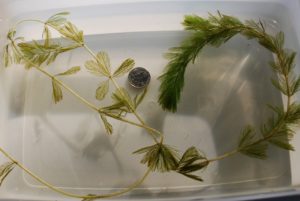
These species are not native to our state and is very difficult to control once it becomes fully established. Milfoil reproduces through fragmentation whereby plant fragments break off from the parent plant through wind or boat action, grow roots, and settle in a new location. Milfoil spreads rapidly and displaces beneficial native plant life. It makes swimming difficult and can devalue waterfront property. Where this species grows in its native environment, insects and fish may feed on this plant at such a rate as to control its growth. Milfoil has no natural predators to keep its population in check. Under optimum temperature, light and nutrient conditions, milfoil may grow up to an inch per day. How Did Exotic Milfoil Become Established in This State? It was most likely a “stowaway” fragment attached to a boat or trailer that came to this region. Milfoil can live out of water for many hours if it remains moist.
Useful Web links:
Department of Ecology of the University of Washington page dedicated to Eurasian Milfolil: http://www.ecy.wa.gov/programs/wq/plants/weeds/milfoil.html
Minnesota Sea Grant: Eurasian Milfoil: Fact Sheet:http://www.seagrant.umn.edu/exotics/eurasian.html
Eurasian Watermilfoil in Vermont: http://www.anr.state.vt.us/dec/waterq/lakes/htm/ans/lp_ewm.htm
Save Black Lake: Eurasian Watermilfoil: http://www.saveblacklake.org/invasive-species/eurasian-water-milfoil
